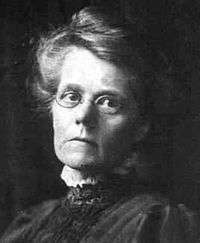Alicia Boole Stott
| Alicia Boole Stott | |
|---|---|
 | |
| Born |
June 8, 1860 Cork, Ireland |
| Died |
December 17, 1940 (aged 80) England |
| Nationality | British |
| Known for | Mathematics |
Alicia Boole Stott (June 8, 1860 – December 17, 1940) was an Irish-English mathematician. Despite never holding an academic position, she made a number of valuable contributions to the field, receiving an honorary doctorate from University of Groningen .[1] She is best known for coining the term "polytope" for a convex solid in four (or more) dimensions, and having an impressive grasp of four-dimensional geometry from a very early age.[1]
Early life
Alicia Boole was born in Cork, Ireland, the third daughter of mathematician and logician George Boole and Mary Everest Boole, a self-taught mathematician and educationalist. Many of her sisters were notable in their own right. Lucy Everest Boole was a chemist and pharmacist and Ethel Lilian Voynich was a novelist. After her father's sudden death in 1864, the family moved to London, where her mother became the librarian at Queen's College, London.[2] She attended the school attached to Queens' College with her sister, but never attended university.
Early career
Alicia was the only Boole sister to inherit her father's mathematical talent, although her mother Mary Everest Boole had brought up all of her five children from an early age 'to acquaint them with the flow of geometry' by projecting shapes onto paper, hanging pendulums etc.[3] She was first exposed to geometric models by her brother-in-law Charles Howard Hinton when she was just 18, and developed the ability to visualise in a fourth dimension.[1][2] She found that there were exactly six regular polytopes in four dimensions and that they are bounded by 5, 16 or 600 tetrahedra, 8 cubes, 24 octahedra or 120 dodecahedra. (Though this was already known to Schläfli) She then produced three-dimensional central cross-sections of all the six regular polytopes by purely Euclidean constructions and synthetic methods for the simple reason that she had never learned any analytic geometry. She made cardboard models of all these sections. She coined the term 'polytopes' to describe them.
Later career
After taking up secretarial work near Liverpool in 1889 she met and married Walter Stott, an actuary, in 1890. They had two children together, Mary (1891-1982) and Leonard (1892-1963).[4] Stott learned of Pieter Schoute's work on central sections of the regular polytopes in 1895. Schoute came to England and worked with Alicia Stott, persuading her to publish her results which she did in two papers published in Amsterdam in 1900 and 1910.[5]
The University of Groningen honoured her by inviting her to attend the tercentenary celebrations of the university and awarding her an honorary doctorate in 1914.[6] After Schoute's death in 1923 Alicia took a hiatus from mathematical work.
In 1930 she was introduced by her nephew Geoffrey Ingram Taylor to H.S.M. Coxeter and they worked together on various problems.[6] Alicia made two further important discoveries relating to constructions for polyhedra related to the golden section. She presented a joint paper with Coxeter at Cambridge University. Coxeter later wrote, "The strength and simplicity of her character combined with the diversity of her interests to make her an inspiring friend."[2]
Legacy
Alicia died in Middlesex in 1940.[6] In Spring 2001 a paper roll of coloured drawings of polyhedra was found at Groningen University.[2] Though unsigned, it was immediately recognised as Alicia's work. It led to research by Irene Polo-Blanco. Polo-Blanco dedicated a chapter to Alicia's work in her book Theory and History of Mathematical Models (2007). The pioneering way of grandfather and mother continued in son Leonard, who assisted in tuberculosis treatment and invented an artificial pneumothorax apparatus.
Publications (external links)
- A. Boole Stott: Geometrical deduction of semiregular from regular polytopes and space fillings, Verhandelingen van de Koninklijke Akademie van Wetenschappen, Verhandelingen Natuurkunde, Eerste Sectie, deel 11, nummer 1 (1910), 1-24. Amsterdam, 1910.
- All publications by A. Boole Stott (as an author and as a co-author) with the Koninklijke Akademie van Wetenschappen
References
- 1 2 3 Morrow, Charlene; Perl, Teri (1998). "Notable Women in Mathematics: A Biographical Dictionary". Greenwood Press. pp. 243–245. Retrieved 4 January 2015 – via Questia. (Subscription required (help)).
- 1 2 3 4 Des MacHale; Anne Mac Lellan. Mulvihill, Mary, ed. Lab Coats and Lace. Women in Technology and Science. ISBN 9780953195312.
- ↑ Gerry Kennedy, The Booles and the Hintons, Atrium Press, July 2016 p 85.
- ↑ Polo-Blanco, Irene (May 2008). "Alicia Boole Stott, a geometer in higher dimension". Historia Mathematica. 35 (2): 123–139. doi:10.1016/j.hm.2007.10.008.
- ↑ W. W. Rouse Ball (1960) Mrs. Stott's Construction, in Mathematical Recreations and Essays, Macmillan, New York, pp 139-140.
- 1 2 3 Franceschetti, Donald R. (1999). "Biographical Encyclopedia of Mathematicians - Vol. 2". Marshall Cavendish. pp. 482–484. Retrieved 4 January 2015 – via Questia. (Subscription required (help)).
Other external links
- "Alicia Boole Stott", Biographies of Women Mathematicians, Agnes Scott College
- O'Connor, John J.; Robertson, Edmund F., "Alicia Boole Stott", MacTutor History of Mathematics archive, University of St Andrews.